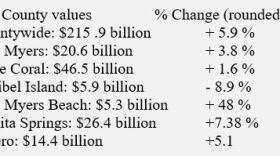It's no surprise that issues that were problems in Southwest Florida before Hurricane Ian morphed into much worse problems in the storm's aftermath.
After months of community engagement to delve into those problems, the ResilientLee & Recovery Task Force concluded its first phase of Ian recovery with an estimated $7 billion, and counting, in countywide projects.
At a summary task force RTF meeting on Friday, held at Collaboratory in downtown Fort Myers, the task force summarized its findings from phase one to identify the needs of the county post-Ian through community outreach.
The municipalities are focused on businesses and the workforce, community resilience, critical infrastructure and attainable and affordable housing.
Facilitated by Collaboratory, the task force is working with eight branches addressing social issues such as infrastructure, housing and economic recovery, among others.
“All of the issues that had existed before the hurricane are now generally much worse,” Collaboratory’s Chief Collaboration Officer Terry Mazany said. “We had a housing crisis before the hurricane. Now we have a – what’s a more significant word than crisis?”
“Mental health was a challenge before,” he said. “And the hurricane hit, and now there’s an acute need for mental health services.”
The task force gathered information through 17 town hall meetings held countywide, community surveys and workshops with subject-matter experts who addressed community project proposals.
To date, the county has received $2.18 billion in grants, $1.1 billion of which was announced in March by the U.S. Department of Housing and Urban Development.
Tanya Shannon is the Deputy Director of Recovery for Hagerty Consulting, an emergency management consulting firm contracted with the task force.
Shannon said that cities and towns need to submit all unmet needs as quickly as possible as an action plan is due to HUD September 20. Until then, the task force will be holding workshops with the respective branches to determine whether each project is feasible.
“Next month and in August, we’re putting meat to the bone, identifying specifically these are the projects [and] utilizing the projects that you have all submitted,” she said.
Shannon said that the proposal the task force submits will demonstrate there is a much larger need than the current allocation, making additional grants possible.
“That is the vision for the Recovery Task Force and the branches and the work that we’re all doing here together, is that larger planning effort in identifying all unmet needs so that it can be better communicated to federal, state partners for additional funding,” Shannon said.
“HUD was very upfront in saying that they did not have data on infrastructure when they calculated the allocation between the state of Florida, Lee County, Kentucky floods, California fires,” she added.
Commissioner Kevin Ruane, who is also the task force chair, encouraged that community representatives continue to submit projects.
“As I said from day one, I’d like to see us be around the $10-billion range,” he said.
Of the HUD grant money, 70% must be used for low- to moderate-income (LMI) households. Ruane said the draft action plan is currently accounting for just over 60% LMI development.
Another initiative addressed at the meeting was the Neighborhood Master Plan, which focuses on damage by specific neighborhood and making each one more resilient for future disasters. So far, 19 neighborhoods have been identified as having a large need, but there is no cap on how many can be assessed.

“If you put Lee County on a map and you fill in all the neighborhoods, we're trying to see if there's any area we've missed,” Ruane said after the meeting.
“In a particular neighborhood, we might have identified power to be an issue there,” he said. “We might identify talking with a power provider, ‘Why are we still overhead with electric?’” rather than running it underground.
Ruane said the challenging part is that the cities all have different providers the task force works with, whether it be Lee County Electric Cooperative or Florida Power & Light, Comcast or Century Link.
“I don't think there's a county around that is controlled entirely by the county or the city when it comes to utilities, especially water and sewer,” he said. “Those are the challenges as we try to identify the resiliency aspect, is what can we do better for the next community?”
During public comments, Fort Myers resident Marsha Ellis asked the task force what its intent was.
“Because I think it's important that we remind ourselves that it's not to throw necessarily accelerant on an economic boom, but to meet unmet need and to assess and address environmental and ecological risk that is impacting our resiliency.”
She said she is “extremely concerned about the impacts of out-of-control growth on our water resources” and “our public health as we face another algae crisis,” as well as flooding caused by an increase in housing development and a decrease in impervious land.
In a later interview, Ellis said she wanted to see more transparency with what changes are being made.
“Even though Municode, which is the platform that hosts our land code, has the option of showing versioning and history and notifying people of meetings and changes, our county is not subscribing to that feature,” she said.
Ruane said the task force is still learning new ways to build a resilient community after “the perfect storm” hit Southwest Florida.
“Every imaginal curveball that we could have received was sent to us, and we're still dealing with them as quickly as we can,” Ruane said. “It's been overwhelming. We're nine months through this, and I feel like it was just yesterday the storm happened.”
WGCU is your trusted source for news and information in Southwest Florida. We are a nonprofit public service, and your support is more critical than ever. Keep public media strong and donate now. Thank you.







